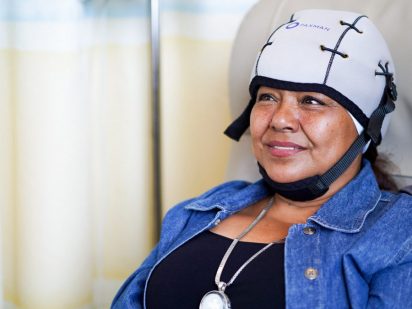Will I lose my hair?” It’s the first question many cancer patients ask when they learn that their recommended treatment regimen includes chemotherapy.
“It is a big stressor,” said Shane Jordan, Director of the Trinity CancerCare Center. “Many patients say it’s the most traumatic aspect of their treatment. I think part of the reason is that people associate hair loss with cancer, so when you’re in public it has a way of announcing that you have cancer.”
Now, thanks to funding from Trinity Health Foundation, the CancerCare Center has become the first center in North Dakota to acquire the Paxman Scalp Cooling System – an optional service for patients who wish to minimize alopecia, or hair loss, from chemotherapy.
Preventing hair loss as a side effect of chemotherapy treatment has long been a subject of research and development. It is estimated that 8 percent of patients refuse chemotherapy because of concerns about losing their hair.
“We kept up with the research and looked at different products, including some that utilize dry ice,” Jordan said. “The Paxman system struck me as the most appropriate for our needs, so with help from the Trinity Health Foundation, we put a plan together to add the system as an option for patients. Based on the initial results, we will continue to offer it.”
Approved by the U.S. Food and Drug Administration in 2018, the Paxman Scalp Cooling System is cleared by FDA for use during treatment of patients with solid tumors such as breast, ovarian, colorectal, and bowel cancer.
“Scalp cooling works by narrowing the blood vessels beneath the skin of the scalp and reducing cell division, which decreases the amount of chemotherapy that reaches and interacts with the hair follicles,” Jordan explained. “With less chemotherapy in the follicles, the hair may be less likely to fall out.” (Interestingly, chemotherapy works by targeting rapidly dividing cells, and hair cells happen to fall into that category.)
To begin the cooling process, a patient dons a two-layer cap that resembles a swim cap. The inner layer contains a cooling liquid and the outer layer acts as an insulator to keep the temperature sufficiently cold. The cap is attached to a small refrigeration unit, which circulates coolant to the cap.
The rate of hair retention varies from patient to patient. While Paxman can’t guarantee that patients won’t lose any, or all, of their hair, data show that its track record is fairly successful. Overall, about 50 percent of patients who used the Paxman system kept some or quite a bit of their hair and didn’t have to wear a wig to avoid looking bald. Anecdotal data also suggests it may facilitate hair growing back more naturally and more quickly.
Jordan emphasizes that scalp cooling isn’t for everyone. It extends the duration of a chemotherapy treatment, as patients must wear the cap before, during, and after treatment.
Studies show that some people experience headaches or find the chill to be too uncomfortable. More importantly, “Because scalp cooling has the effect of dampening the medicinal effects of chemotherapy on the scalp, it isn’t recommended for head and neck cancers or systemic cancers such as leukemia,” he added.
Scalp cooling does involve expense to the patient. While the CancerCare Center pays for lease of the refrigeration unit, the Paxman Personal Cap Kit costs the patient $500, including the cooling cap, cap cover, brush, special shampoo and other hair products, plus tokens to run the machine that delivers the coolant. Patients also pay an additional fee each time the system is used, based on Paxman’s pricing matrix. Fees are capped at a maximum of $2,200, so patients never pay more than that.
Jordan said since the CancerCare Center acquired the scalp cooling device, a handful of patients have used it, and results have been mostly positive.
“We’re always on the lookout for ways to enhance our level of service, whether through new procedures, advanced technology, new treatment regimens, cancer exercise, yoga, or our survivorship program,” Jordan declared. “Our objective is always to improve the quality of life for our patients.”

